A Web-Based Tool for Energy Balance Estimation in Multiple-Crops Production Systems
Abstract
:1. Introduction
2. Materials and Methods
2.1. Overall Description of the System
2.2. Input
2.2.1. Fields and Crops Data
2.2.2. Resources
2.3. Embedded Databases
2.4. Process
- The required tractive efficiency for a specific operation. Tractive efficiency is used for the estimation of the equivalent PTO (power-take-off).
- The rotary power requirement parameters, also required for the estimation of the equivalent PTO.
- The soil texture adjustment parameter, required for the estimation of the implement draft according to the soil category that has been specified by the user for a specific field.
- The machine parameters, required for the estimation of the implement draft.
2.5. Output
2.6. Case Study Description
3. Results
4. Relation between the Energy and Economic Indexes of the Production
5. Conclusions
Acknowledgments
Author Contributions
Conflicts of Interest
Abbreviations
| EB | Energy balance per unit area |
| EI | Energy input |
| EIUA | Energy input per unit area |
| EIUM | Energy input per unit mass |
| EO | Energy output |
| EOU | Energy output per unit area |
| EROI | Energy return to investment |
| MCI | Microirrigation system |
| MIUA | Monetary input per unit area |
| MROI | Monetary return on investment |
| MRS | Mobile rain gun irrigation system |
| PTO | Power take off |
References
- De Besi, M.; McCormick, K. Towards a bioeconomy in Europe: National, regional and industrial strategies. Sustainability 2015, 7, 10461–10478. [Google Scholar] [CrossRef]
- Ba, B.H.; Prins, C.; Prodhon, C. Models for optimization and performance evaluation of biomass supply chains: An Operations Research perspective. Renew. Energy 2016, 87, 977–989. [Google Scholar] [CrossRef]
- Pinho, T.M.; Coelho, J.P.; Moreira, A.P.; Boaventura-Cunha, J. Modelling a biomass supply chain through discrete-event simulation. IFAC Pap. OnLine 2016, 49, 84–89. [Google Scholar] [CrossRef]
- Zhang, F.; Johnson, D.M.; Johnson, M.A. Development of a simulation model of biomass supply chain for biofuel production. Renew. Energy 2012, 44, 380–391. [Google Scholar] [CrossRef]
- Pavlou, D.; Orfanou, A.; Busato, P.; Berruto, R.; Sørensen, C.; Bochtis, D. Functional modeling for green biomass supply chains. Comput. Electron. Agric. 2016, 122, 29–40. [Google Scholar] [CrossRef]
- Gissén, C.; Prade, T.; Kreuger, E.; Nges, I.A.; Rosenqvist, H.; Svensson, S.-E.; Lantz, M.; Mattsson, J.E.; Börjesson, P.; Björnsson, L. Comparing energy crops for biogas production—Yields, energy input and costs in cultivation using digestate and mineral fertilisation. Biomass Bioenergy 2014, 64, 199–210. [Google Scholar] [CrossRef]
- Börjesson, P.; Tufvesson, L.M. Agricultural crop-based biofuels—Resource efficiency and environmental performance including direct land use changes. J. Clean. Prod. 2011, 19, 108–120. [Google Scholar] [CrossRef]
- Kavargiris, S.E.; Mamolos, A.P.; Tsatsarelis, C.A.; Nikolaidou, A.E.; Kalburtji, K.L. Energy resources’ utilization in organic and conventional vineyards: Energy flow, greenhouse gas emissions and biofuel production. Biomass Bioenergy 2009, 33, 1239–1250. [Google Scholar] [CrossRef]
- Michos, M.C.; Mamolos, A.P.; Menexes, G.C.; Tsatsarelis, C.A.; Tsirakoglou, V.M.; Kalburtji, K.L. Energy inputs, outputs and greenhouse gas emissions in organic, integrated and conventional peach orchards. Ecol. Indic. 2012, 13, 22–28. [Google Scholar] [CrossRef]
- Liu, Y.; Langer, V.; Høgh-Jensen, H.; Egelyng, H. Energy Use in Organic, Green and Conventional Pear Producing Systems—Cases from China. J. Sustain. Agric. 2010, 34, 630–646. [Google Scholar] [CrossRef]
- Strapatsa, A.V.; Nanos, G.D.; Tsatsarelis, C.A. Energy flow for integrated apple production in Greece. Agric. Ecosyst. Environ. 2006, 116, 176–180. [Google Scholar] [CrossRef]
- Milà i Canals, L.; Burnip, G.M.; Cowell, S.J. Evaluation of the environmental impacts of apple production using Life Cycle Assessment (LCA): Case study in New Zealand. Agric. Ecosyst. Environ. 2006, 114, 226–238. [Google Scholar] [CrossRef]
- Kaltsas, A.M.; Mamolos, A.P.; Tsatsarelis, C.A.; Nanos, G.D.; Kalburtji, K.L. Energy budget in organic and conventional olive groves. Agric. Ecosyst. Environ. 2007, 122, 243–251. [Google Scholar] [CrossRef]
- Zafiriou, P.; Mamolos, A.P.; Menexes, G.C.; Siomos, A.S.; Tsatsarelis, C.A.; Kalburtji, K.L. Analysis of energy flow and greenhouse gas emissions in organic, integrated and conventional cultivation of white asparagus by PCA and HCA: Cases in Greece. J. Clean. Prod. 2012, 29, 20–27. [Google Scholar] [CrossRef]
- Litskas, V.D.; Mamolos, A.P.; Kalburtji, K.L.; Tsatsarelis, C.A.; Kiose-Kampasakali, E. Energy flow and greenhouse gas emissions in organic and conventional sweet cherry orchards located in or close to Natura 2000 sites. Biomass Bioenergy 2011, 35, 1302–1310. [Google Scholar] [CrossRef]
- Stolarski, M.J.; Krzyżaniak, M.; Tworkowski, J.; Szczukowski, S.; Gołaszewski, J. Energy intensity and energy ratio in producing willow chips as feedstock for an integrated biorefinery. Biosyst. Eng. 2014, 123, 19–28. [Google Scholar] [CrossRef]
- Sørensen, C.G.; Halberg, N.; Oudshoorn, F.W.; Petersen, B.M.; Dalgaard, R. Energy inputs and GHG emissions of tillage systems. Biosyst. Eng. 2014, 120, 2–14. [Google Scholar] [CrossRef]
- Sopegno, A.; Rodias, E.; Bochtis, D.; Busato, P.; Berruto, R.; Boero, V.; Sørensen, C. Model for energy analysis of Miscanthus production and transportation. Energies 2016, 9, 392. [Google Scholar] [CrossRef]
- Busato, P.; Sørensen, C.G.; Pavlou, D.; Bochtis, D.D.; Berruto, R.; Orfanou, A. DSS tool for the implementation and operation of an umbilical system applying organic fertiliser. Biosyst. Eng. 2013, 114, 9–20. [Google Scholar] [CrossRef]
- Busato, P.; Berruto, R. A web-based tool for biomass production systems. Biosyst. Eng. 2014, 120, 102–116. [Google Scholar] [CrossRef]
- ASAE D497.5. Agricultural machinery management data. In ASABE STANDARD 2009, Vol. I; American Society of Agricultural and Biological Engineers: St. Joseph, MI, USA, 2009; pp. 360–367. [Google Scholar]
- Pimentel, D. Handbook of Energy Utilization in Agriculture; CRC Press, Inc.: Boca Raton, FL, USA, 1980. [Google Scholar]
- Nagy, C. Energy Coefficient for Agriculture Inputs in Western Canada; University of Saskatchewan: Saskatoon, SK, Canada, 1999. [Google Scholar]
- Chamsing, A.; Salokhe, V.M.; Singh, G. Energy Consumption Analysis for Selected Crops in Different Regions of Thailand. Agric. Eng. Int. 2006, VIII, 1–18. [Google Scholar]
- Nassiri, S.M.; Singh, S. Study on energy use efficiency for paddy crop using data envelopment analysis (DEA) technique. Appl. Energy 2009, 86, 1320–1325. [Google Scholar] [CrossRef]
- Dalgaard, T.; Halberg, N.; Porter, J.R. A model for fossil energy use in Danish agriculture used to compare organic and conventional farming. Agric. Ecosyst. Environ. 2001, 87, 51–65. [Google Scholar] [CrossRef]
- ASAE EP496.3. Agricultural machinery management. In ASABE STANDARD 2009; ASABE, Ed.; American Society of Agricultural and Biological Engineers: St. Joseph, MI, USA, 2009; Volume I, pp. 354–357. [Google Scholar]
- Hülsbergen, K.-J.; Feil, B.; Biermann, S.; Rathke, G.-W.; Kalk, W.-D.; Diepenbrock, W. A method of energy balancing in crop production and its application in a long-term fertilizer trial. Agric. Ecosyst. Environ. 2001, 86, 303–321. [Google Scholar] [CrossRef]
- Ozturk, H.H.; Ekinci, K.; Barut, Z.B. Energy analysis of the tillage systems in second crop corn production. J. Sustain. Agric. 2006, 28, 25–37. [Google Scholar] [CrossRef]
- Rathke, G.W.; Diepenbrock, W. Energy balance of winter oilseed rape (Brassica napus L.) cropping as related to nitrogen supply and preceding crop. Eur. J. Agron. 2006, 24, 35–44. [Google Scholar] [CrossRef]
- Veiga, J.P.S.; Romanelli, T.L.; Gimenez, L.M.; Busato, P.; Milan, M. Energy embodiment in Brazilian agriculture: An overview of 23 crops. Sci. Agric. 2015, 72, 471–477. [Google Scholar] [CrossRef]
- Romanelli, T.L.; Milan, M. Material flow determination through agricultural machinery management. Sci. Agric. 2010, 67, 375–383. [Google Scholar] [CrossRef]
- Gubiani, R.D. Corn utilization in a family-boiler: Greenhouse emissions, economic estimation and energy assessment. In Agricultural and Biosystems Engineering for a Sustainable World; European Society of Agricultural Engineers: Hersonissos, Greece, 2008. [Google Scholar]
- Persson, T.; Paz, J.; Hoogenboom, G.; Garcia, A.G.Y.; Jones, J.W. Net energy value of maize ethanol as a response to different climate and soil conditions in the southeastern USA. Biomass Bioenergy 2009, 33, 1055–1064. [Google Scholar] [CrossRef]
- Piringer, G.; Steinberg, L.J. Reevaluation of energy use in wheat production in the United States. J. Ind. Ecol. 2006, 10, 149–167. [Google Scholar] [CrossRef]
- Ray, S.; Pramanick, M.; Mani, P.K.; Roy, K.; Sengupta, K.M.C.; Ray, S.; Pramanick, P.K.; Roy, K.M.; Chatterjee, M.; Mani, K.S. Diversification of rice-based cropping system and their impact on energy utilization and system production. J. Crop Weed 2009, 5, 167–170. [Google Scholar]
- Deike, S.; Pallutt, B.; Christen, O. Investigations on the energy efficiency of organic and integrated farming with specific emphasis on pesticide use intensity. Eur. J. Agron. 2008, 28, 461–470. [Google Scholar] [CrossRef]
- Swanton, C.J.; Murphy, S.D.; Hume, D.J.; Clements, D.R. Recent improvements in the energy efficiency of agriculture: Case studies from Ontario, Canada. Agric. Syst. 1996, 52, 399–418. [Google Scholar] [CrossRef]
- Pimentel, D.; Pimentel, M.; Karpenstein, M. Energy use in agriculture: An overview. CIGR E J. 1999, 1, 1–32. [Google Scholar]
- Venturi, P.; Venturi, G. Analysis of energy comparison for crops in European agricultural systems. Biomass Bioenergy 2003, 25, 235–255. [Google Scholar] [CrossRef]
- Nanda, S.S.; Mohanty, M.; Pradhan, K.C.; Mohanty, A.K.; Mishra, M.M. Production potential, profitability and energy efficient rice based cropping systems for coastal Orissa. J. Farming Syst. Res. Dev. 2008, 14, 1–5. [Google Scholar]
- Hernanz, J.L.; Giron, V.S.; Cerisola, C. Long-term energy use and economic evaluation of three tillage systems for cereal and legume production in central Spain. Soil Tillage Res. 1995, 35, 183–198. [Google Scholar] [CrossRef]
- Boswell, M.J. Hardie Irrigation Micro-Irrigation Design, 4th ed.; Edagricole: Bologna, Italy, 1993. [Google Scholar]
- Pereira, L.S.; Trout, J. Irrigation methods. In CIGR Handbook of Agricultural Engineering, Volume I: Land and Water Engineering; American Society of Agricultural Engineers: St. Joseph, MI, USA, 1999; pp. 297–379. [Google Scholar]
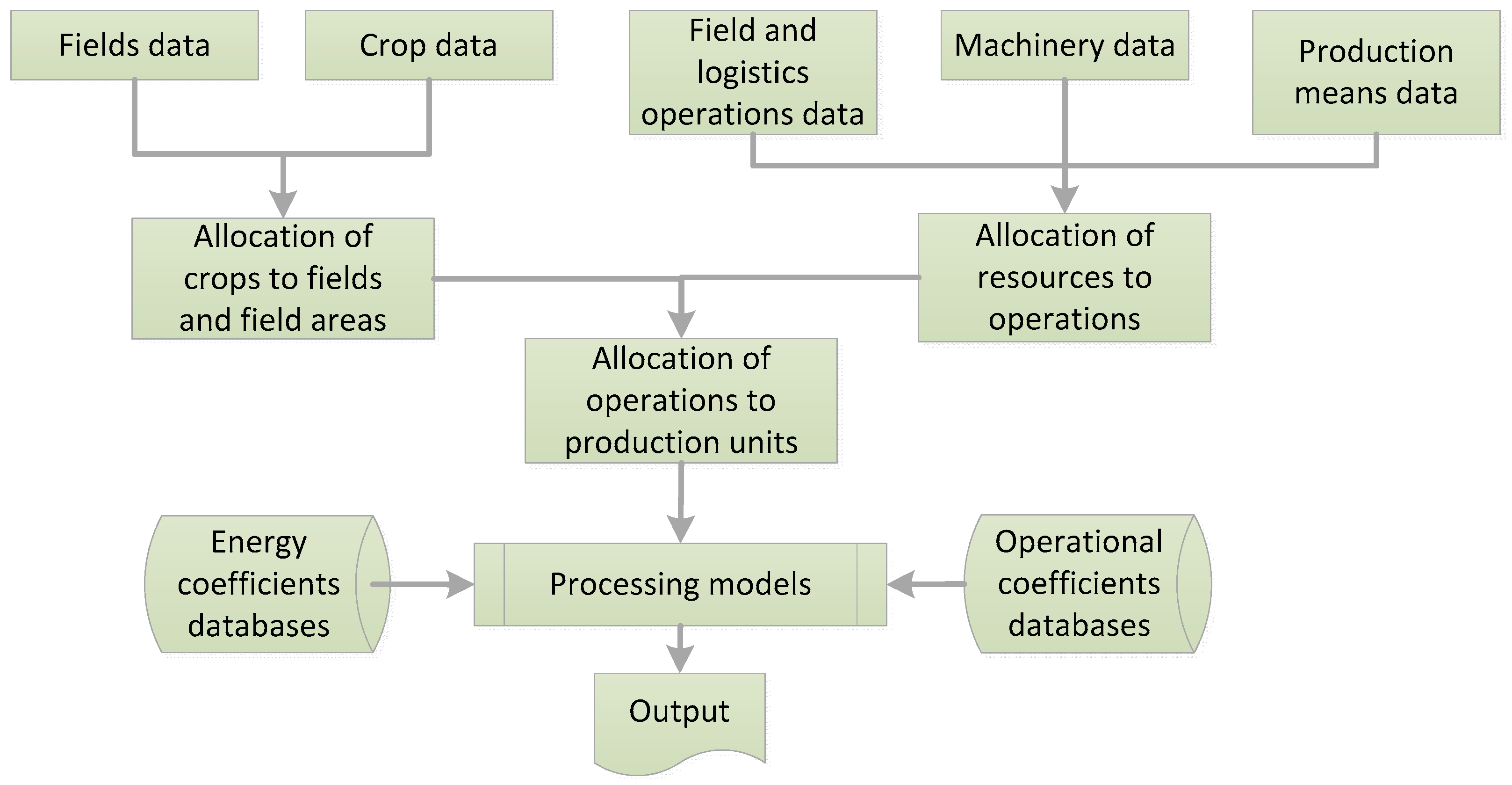

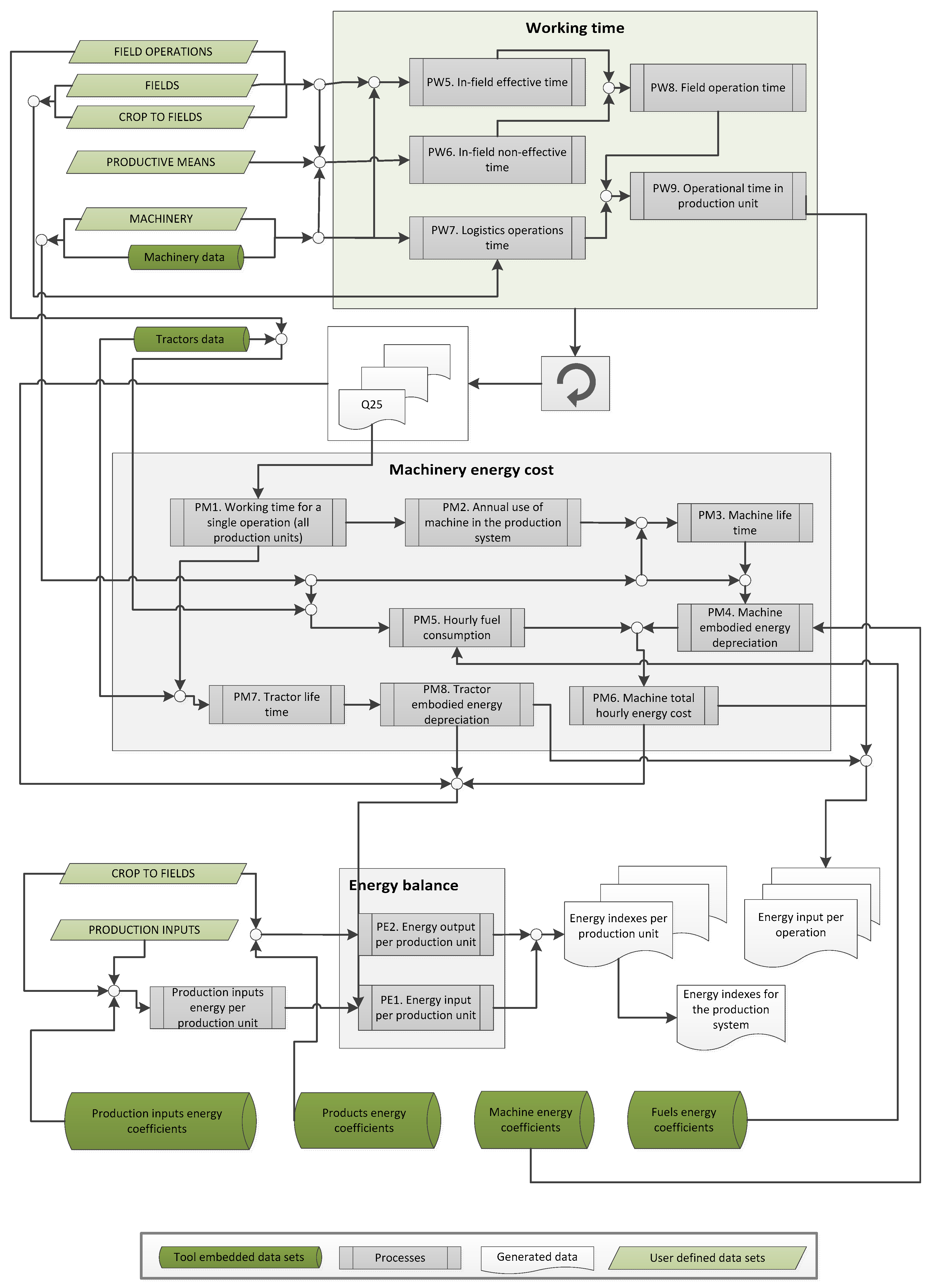
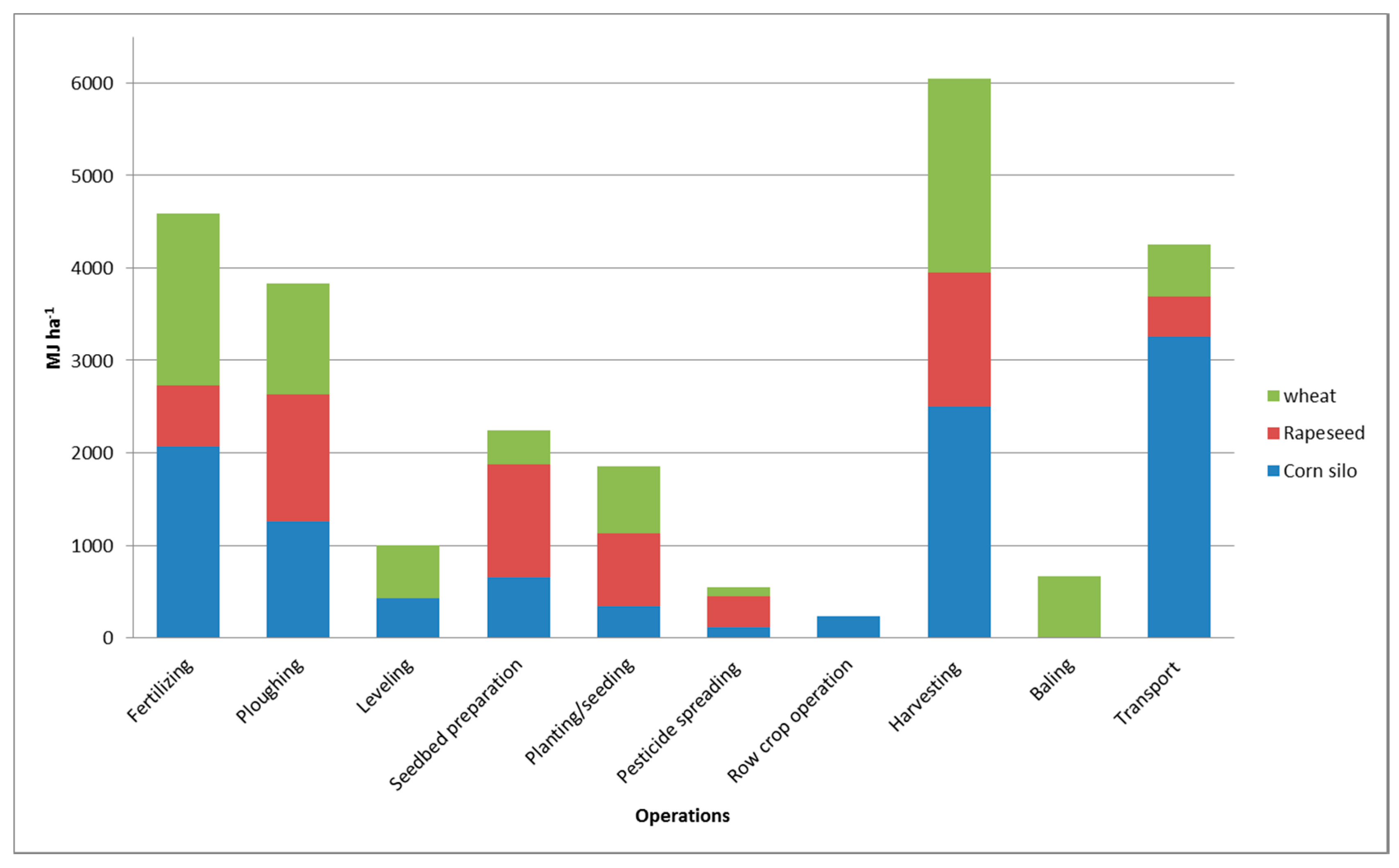
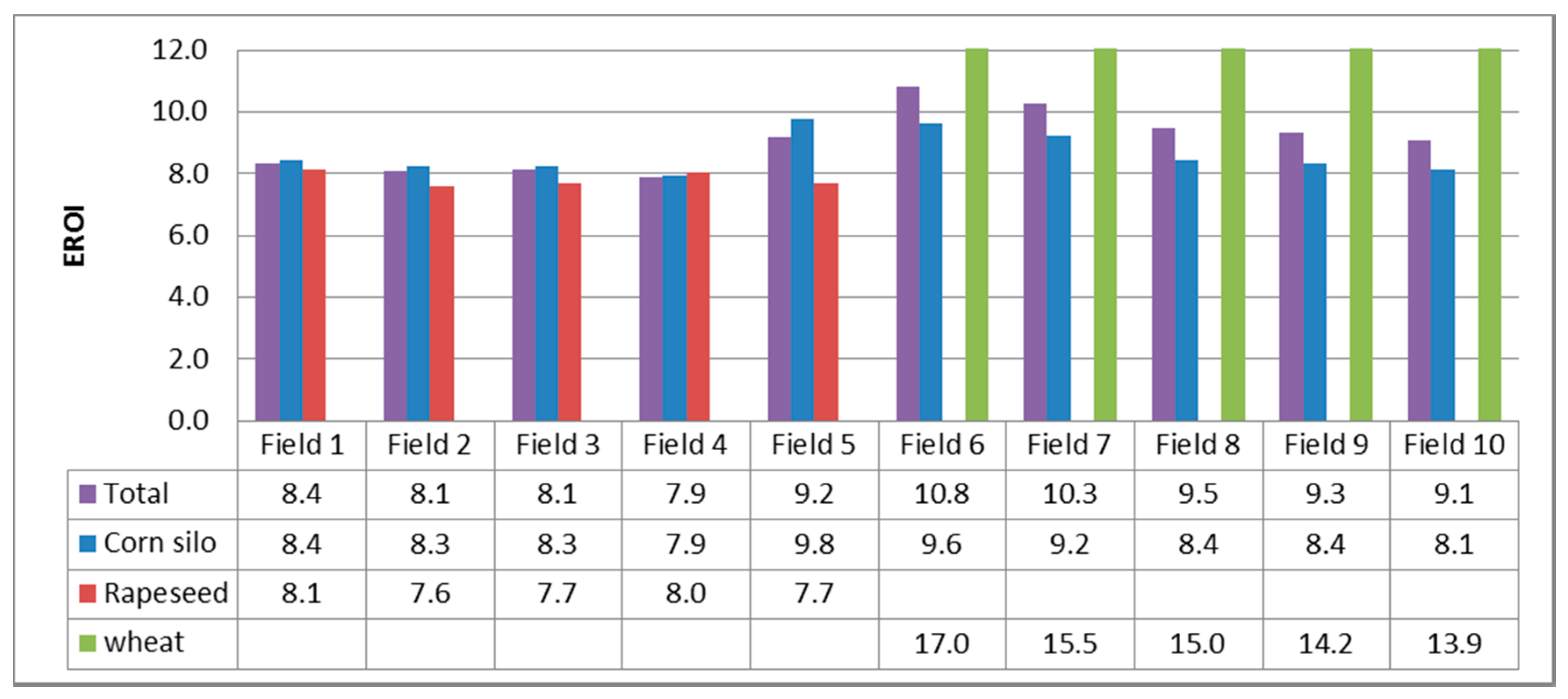
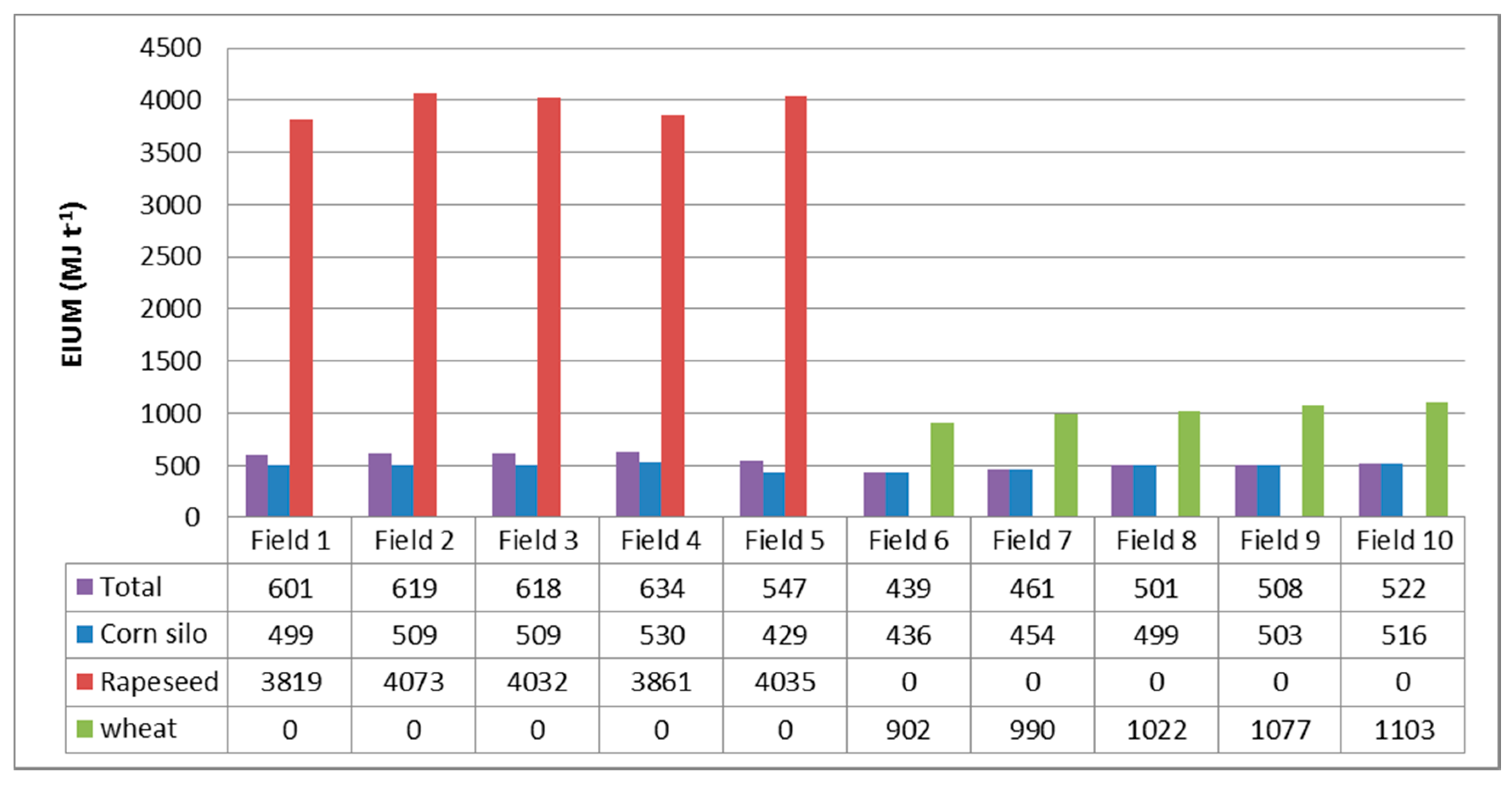
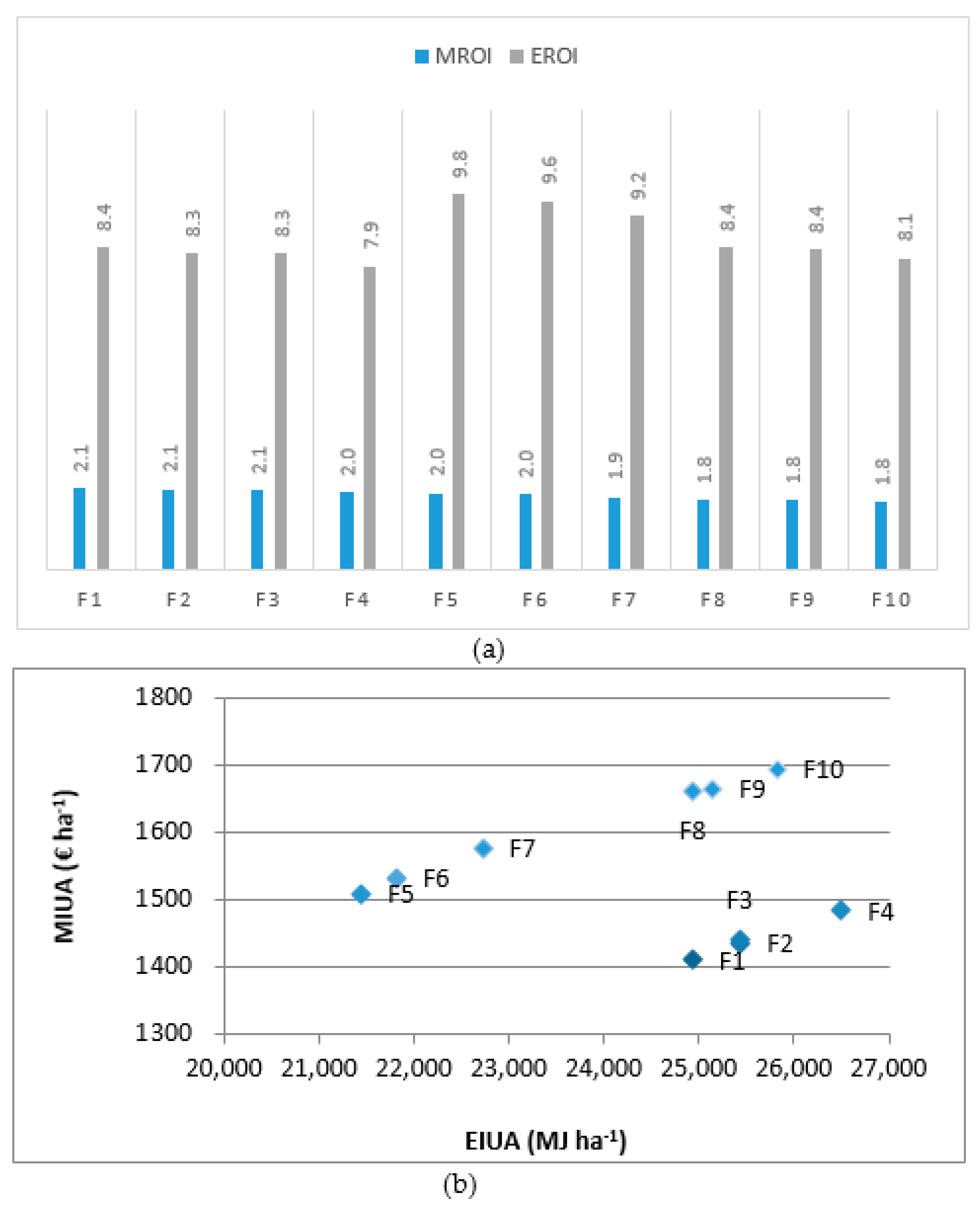
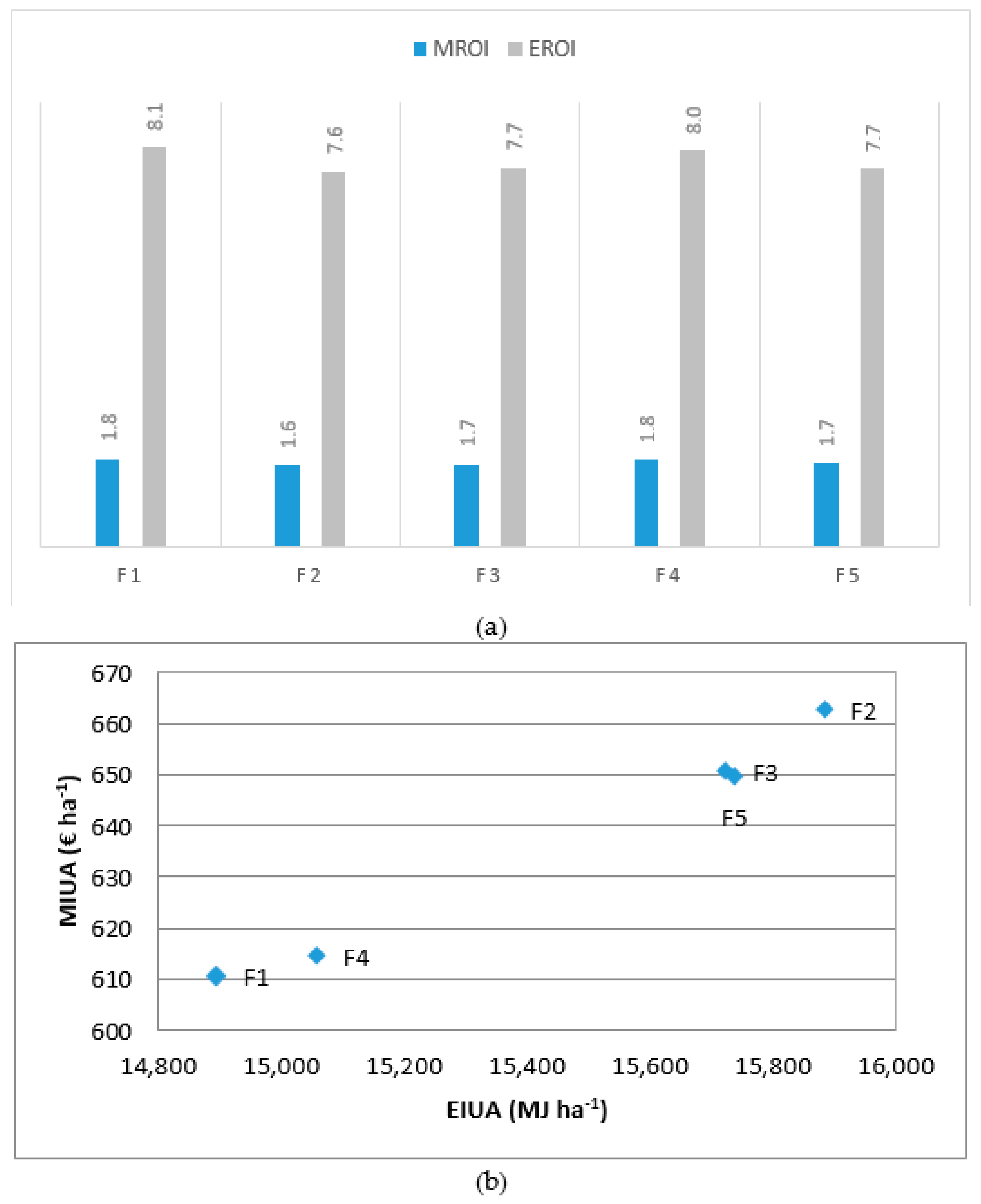
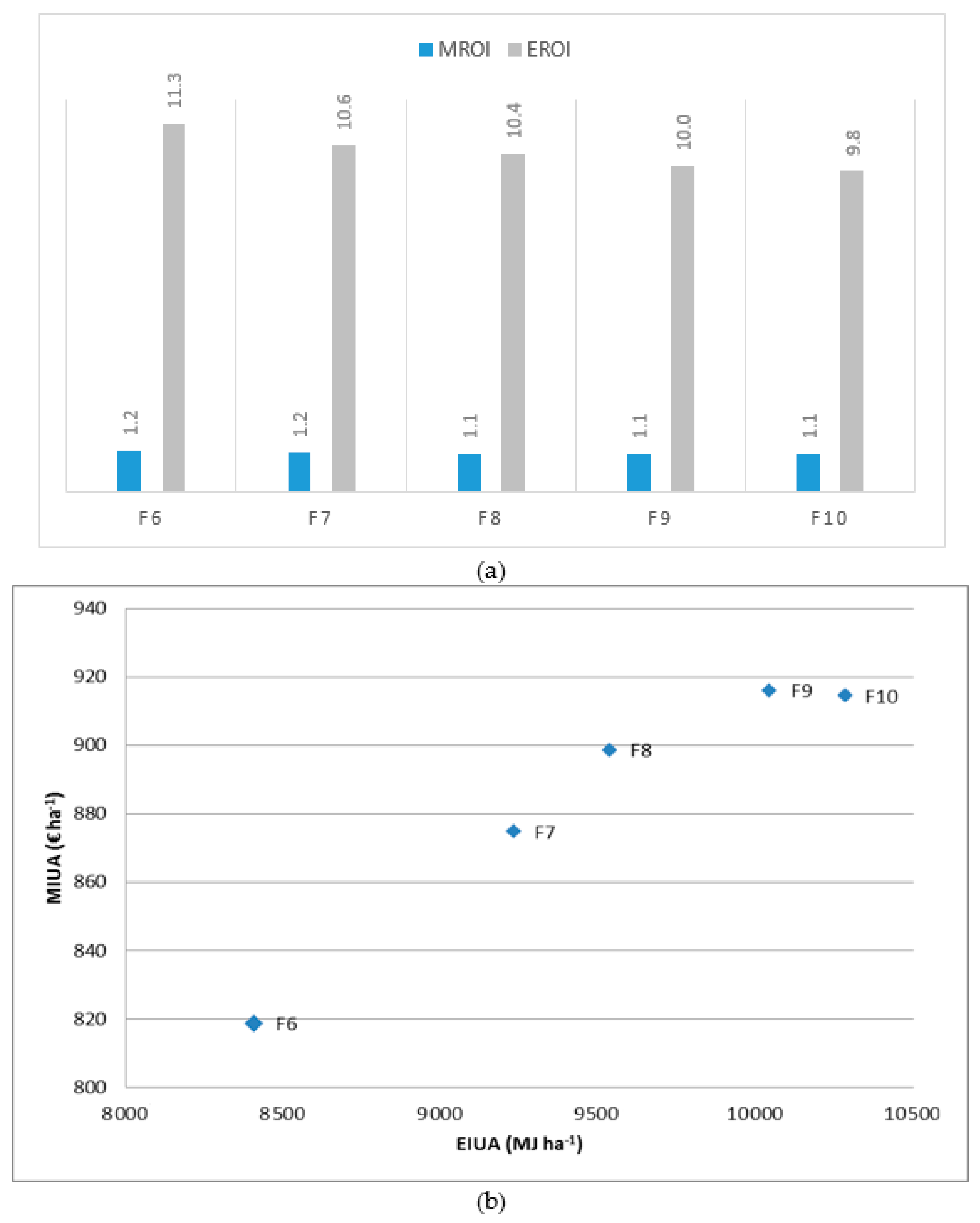
| Data Base | Resources |
|---|---|
| Fuels and oils | [22,23,24,25] |
| Machinery | [26,27,28,29,30,31,32] |
| Agrochemicals (fertilizers, herbicides, pesticides, fungicides) | [24,25,26,28,29,33,34,35,36,37] |
| Propagation means and seeds | [22,25,35,38,39,40] |
| Products | [33,38,41,42] |
| Field ID | F1 | F2 | F3 | F4 | F5 | F6 | F7 | F8 | F9 | F10 |
|---|---|---|---|---|---|---|---|---|---|---|
| Area (ha) | 14.2 | 4.4 | 3.0 | 5.5 | 12.0 | 6.3 | 3.8 | 6.1 | 15.5 | 9.2 |
| Distance (km) | 0.8 | 1.2 | 0.7 | 3.0 | 5.5 | 6.0 | 7.0 | 12.0 | 13.0 | 14.0 |
| Transport speed (km h−1) | 18 | 21 | 18 | 24 | 30 | 35 | 35 | 35 | 35 | 35 |
| Soil workability | easy | easy | medium | easy | easy | easy | medium | easy | easy | easy |
| Irrigation (*) | MRS | MRS | MRS | MRS | MCI | MCI | MCI | MCI | MCI | MCI |
| Corn silo | 14.2 | 4.4 | 3.0 | 5.5 | 12.0 | 6.3 | 3.8 | 6.1 | 15.5 | 9.2 |
| Wheat | 7 | 2.2 | 1.5 | 2.8 | 6 | - | ||||
| Rapeseed | - | 3.2 | 1.9 | 3 | 7.8 | 4.6 |
| Field Operations | Crop | |||||
|---|---|---|---|---|---|---|
| Silage Maize | Rapeseed | Wheat | ||||
| ID | Working Speed (km h−1) | ID | Working Speed (km h−1) | ID | Working Speed (km h−1) | |
| Fertilizing | FO1 | 4 | FO12, FO15, FO16 | 7 | FO21 | 7 |
| Ploughing | FO2 | 5.5 | FO9 | 5.5 | FO15 | 5.5 |
| Leveling | FO3 | 5 | - | - | FO18 | 4.5 |
| Seedbed preparation 1 | FO4 | 4.5 | FO10 | 4.5 | FO19 | 5.5 |
| Seedbed preparation 2 | FO6 | 4.5 | FO11 | 4.5 | - | - |
| Planting/seeding | FO5 | 5 | FO13 | 5 | FO20 | 5.5 |
| Pesticide spreading | FO7 | 5 | FO14 | 5 | FO22 | 5 |
| Row crop operation | FO8 | 5 | - | - | - | - |
| Harvesting | FO23 | 5 | FO24 | 5.6 | FO25 | 5.6 |
| Baling | - | - | - | - | FO26 | 6.7 |
| Crop | ID | Machinery | Operation | ||
|---|---|---|---|---|---|
| Loading Time (min) | Unloading Time (min) | Traveling Speed (km h−1) | |||
| Corn Silo | LO1 | T2/M11 | 7.5 | 3 | F1–F3: 25 F4–F6: 30 F7: 35 F8–F10: 40 |
| Rapeseed | LO2 | T3/M11 | 92 | 5 | F6: 30 F7: 35 F8–F10: 40 |
| Wheat (grain) | LO3 | T3/M11 | 82 | 5 | F1–F3: 25 F4–F5: 30 |
| Wheat (straw) | LO4 | 24 | 15 | ||
| Tractors | ||||||
| ID | Weight (kg) | Drive | Power (kW) | Other Use (h) | Operations | |
| T1 | 5610 | 4WD | 100 | 50 | FO1; FO2; FO3; FO5; FO8 | |
| T2 | 3870 | 2WD | 70 | 0 | FO6; FO7; FO4 | |
| T3 | 4810 | 4WD | 90 | 70 | FO10–FO22 | |
| Machines | ||||||
| ID | Type | Weight (kg) | Working Width (m) | Load Capacity (kg) | Other Use (h) | Operations |
| M1 | Liquid organic fertilizer tank | 4000 | 6 | 5800 | 0 | FO1; FO21 |
| M2 | Moldboard plow | 950 | 0.8 | - | 0 | FO2; FO9; FO17 |
| M3 | Leveller | 650 | 2 | - | 0 | FO3; FO18 |
| M4 | Disk tiller | 800 | 2.4 | - | 0 | FO4; FO10; FO19 |
| M5 | Corn planter | 910 | 3 | - | 50 | FO5 |
| M6 | Sprayer | 850 | 12 | 600 | 0 | FO7; FO14; FO22 |
| M7 | Hoeing | 410 | 4.5 | - | 0 | FO8 |
| M8 | Packer | 900 | 2.8 | - | 0 | FO11 |
| M9 | Centrifuge spreader | 350 | 10 | 1000 | 0 | FO12; FO15; FO16 |
| M10 | Winter crops seeder | 540 | 2.5 | 500 | 0 | FO13 |
| M11 | Transport wagon | 4600 | - | 12,000; 4800 # | 0 | LO1–LO4 |
| Corn Silo | Rapeseed | Wheat | ||||
|---|---|---|---|---|---|---|
| Dosage (kg ha−1) | Energy (MJ ha−1) | Dosage (kg ha−1) | Energy (MJ ha−1) | Dosage (kg ha−1) | Energy (MJ ha−1) | |
| Seeds | 19 | 418 | 7.6 | 167 | 240 | 1080 |
| Digestate—organic fertilizer | 50,000 | 0 | - | - | 56,500 | 0 |
| Fertilizer Potassium Chloride | - | - | 140 | 784 | - | - |
| Fertilizer Ammonia Nitrate | - | - | 176 | 3467 | - | - |
| Fertilizer—Urea | 100 | 3160 | 130 | 4108 | - | - |
| Herbicide | 2 × 4 | 1837 | 2 | 588 | - | - |
| Corn Silo | Rapeseed | Wheat | System | |
|---|---|---|---|---|
| Operations Input (MJ ha−1) | 10,871.80 | 6244.49 | 8145.34 | 14,457.38 |
| Resources input (MJ ha−1) | 5415.50 | 9114.40 | 1080.00 | 8014.32 |
| EIUA (MJ ha−1) | 23,812.30 | 15,358.89 | 9225.34 | 29,996.69 |
| EI (MJ) | 1,904,984.00 | 314,857.25 | 179,894.13 | 2,399,735.38 |
| EOUA (MJ ha−1) | 210,000.00 | 120,900.00 | 140,325.00 | 275,184.84 |
| EO (MJ) | 16,800,000.00 | 2,478,450.00 | 2,736,337.50 | 22,014,787.50 |
| EBUA (MJ ha−1) | 186,187.70 | 105,541.11 | 131,099.66 | 245,188.15 |
| EB (MJ) | 14,895,016.00 | 2,163,592.76 | 2,556,443.37 | 19,615,052.13 |
| EROI | 8.82 | 7.87 | 15.21 | 9.17 |
| EIUM (MJ t−1) | 476.00 | 3938.00 | 1008.00 | 564.00 |
© 2017 by the authors. Licensee MDPI, Basel, Switzerland. This article is an open access article distributed under the terms and conditions of the Creative Commons Attribution (CC BY) license (http://creativecommons.org/licenses/by/4.0/).
Share and Cite
Busato, P.; Sopegno, A.; Berruto, R.; Bochtis, D.; Calvo, A. A Web-Based Tool for Energy Balance Estimation in Multiple-Crops Production Systems. Sustainability 2017, 9, 789. https://doi.org/10.3390/su9050789
Busato P, Sopegno A, Berruto R, Bochtis D, Calvo A. A Web-Based Tool for Energy Balance Estimation in Multiple-Crops Production Systems. Sustainability. 2017; 9(5):789. https://doi.org/10.3390/su9050789
Chicago/Turabian StyleBusato, Patrizia, Alessandro Sopegno, Remigio Berruto, Dionysis Bochtis, and Angela Calvo. 2017. "A Web-Based Tool for Energy Balance Estimation in Multiple-Crops Production Systems" Sustainability 9, no. 5: 789. https://doi.org/10.3390/su9050789
APA StyleBusato, P., Sopegno, A., Berruto, R., Bochtis, D., & Calvo, A. (2017). A Web-Based Tool for Energy Balance Estimation in Multiple-Crops Production Systems. Sustainability, 9(5), 789. https://doi.org/10.3390/su9050789






